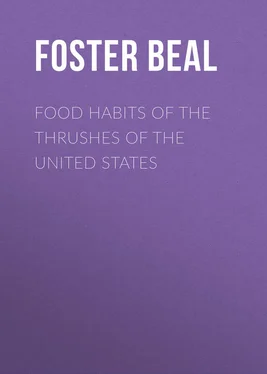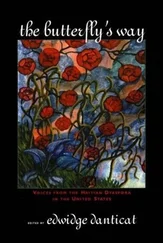Foster Beal - Food Habits of the Thrushes of the United States
Здесь есть возможность читать онлайн «Foster Beal - Food Habits of the Thrushes of the United States» — ознакомительный отрывок электронной книги совершенно бесплатно, а после прочтения отрывка купить полную версию. В некоторых случаях можно слушать аудио, скачать через торрент в формате fb2 и присутствует краткое содержание. ISBN: , Жанр: foreign_antique, foreign_prose, на английском языке. Описание произведения, (предисловие) а так же отзывы посетителей доступны на портале библиотеки ЛибКат.
- Название:Food Habits of the Thrushes of the United States
- Автор:
- Жанр:
- Год:неизвестен
- ISBN:http://www.gutenberg.org/ebooks/33935
- Рейтинг книги:4 / 5. Голосов: 1
-
Избранное:Добавить в избранное
- Отзывы:
-
Ваша оценка:
- 80
- 1
- 2
- 3
- 4
- 5
Food Habits of the Thrushes of the United States: краткое содержание, описание и аннотация
Предлагаем к чтению аннотацию, описание, краткое содержание или предисловие (зависит от того, что написал сам автор книги «Food Habits of the Thrushes of the United States»). Если вы не нашли необходимую информацию о книге — напишите в комментариях, мы постараемся отыскать её.
Food Habits of the Thrushes of the United States — читать онлайн ознакомительный отрывок
Ниже представлен текст книги, разбитый по страницам. Система сохранения места последней прочитанной страницы, позволяет с удобством читать онлайн бесплатно книгу «Food Habits of the Thrushes of the United States», без необходимости каждый раз заново искать на чём Вы остановились. Поставьте закладку, и сможете в любой момент перейти на страницу, на которой закончили чтение.
Интервал:
Закладка:
Food Habits of the Thrushes of the United States / USDA Bulletin 280
INTRODUCTION
North American thrushes (Turdidæ) constitute a small but interesting group of birds, most of which are of retiring habits but noted as songsters. They consist of the birds commonly known as thrushes, robins, bluebirds, Townsend's solitaire, and the wheatears. The red-winged thrush of Europe ( Turdus musicus ) is accidental in Greenland, and the wheatears ( Saxicola œnanthe subspp.) are rarely found in the Western Hemisphere except in Arctic America. Within the limits of the United States are 11 species of thrushes, of which the following 6 are discussed in this bulletin: Townsend's solitaire ( Myadestes townsendi ), the wood thrush ( Hylocichla mustelina ), the veery and willow thrush ( Hylocichla fuscescens subspp.), the gray-cheeked and Bicknell's thrushes ( Hylocichla aliciæ subspp.), the olive-backed and russet-backed thrushes ( Hylocichla ustulata subspp.), and the hermit thrushes ( Hylocichla guttata subspp.). An account of the food habits of the 5 species of robins and bluebirds appeared in Department Bulletin No. 171.
As a group thrushes are plainly colored and seem to be especially adapted to thickly settled rural districts, as the shyest of them, with the exception of the solitaire, do not require any greater seclusion than that afforded by an acre or two of woodland or swamp.
The thrushes are largely insectivorous, and also are fond of spiders, myriapods, sowbugs, snails, and angleworms. The vegetable portion of their diet consists mostly of berries and other small fruits. As a family thrushes can not be called clean feeders, for the food eaten often contains a considerable proportion of such matter as dead leaves, stems, and other parts of more or less decayed vegetation. It might be supposed that this was gathered from the ground with insects and other food, but investigation shows that much of it has a different origin. It was noticed that the setæ or spines of earthworms were a very common accompaniment of this decayed vegetation. Earthworms themselves are rather rarely found in stomachs, although some birds, as the robin, eat them freely. It is well known that the food of earthworms consists largely of partially decayed vegetable matter found in the soil. Hence it is probable that decayed vegetation found in the stomachs of thrushes is the food contained in the earthworms when they were swallowed. The tissues of worms are quickly digested, leaving the contents of their alimentary canals mixed with the hard indigestible setæ or spines.
Thrushes of the genus Hylocichla show a very pronounced taste for ants, and the average consumption of these insects by the five species is 12.65 per cent. Few birds other than woodpeckers show so strong a liking for this highly flavored food. Hymenoptera in general, including ants, bees, and wasps, are the second largest item of insect food. Lepidoptera (caterpillars) stand next as an article of thrush diet, while Orthoptera (grasshoppers), which are a favorite food with most birds, do not seem to appeal much to the thrushes.
The thrushes are pronounced ground feeders, and may often be seen picking small fruit that has fallen to the ground. The vegetable portion of their food (40.72 per cent) is largely composed of fruit, which constitutes over 34 per cent of the total food. Of this 30.88 per cent is made up of wild berries, which outweigh the domestic varieties with every species. In all, 94 species of wild fruits or berries were identified in the stomachs of these birds, although it is not always practicable to identify such material unless seeds or some other characteristic parts are present. As this is not often the case, a considerable portion of the stomach contents must be pronounced "fruit pulp" without further identification; thus probably many more species are eaten than are recorded. Moreover, in the case of some fruits, it is not possible to distinguish species by the seeds, so that many species go unrecognized except as to genus. Domestic fruits are eaten so sparingly by the thrushes here considered as to be of no economic importance.
Note. – This bulletin treats of the economic relations and value to agriculture of the thrushes of the United States other than robins and bluebirds. These two forms were discussed in Department Bulletin No. 171, issued February 5, 1915.
TOWNSEND'S SOLITAIRE
Townsend's solitaire, a bird of the far West, is a resident of high mountains and lonely gorges. It is partial to running streams and often builds its nest just above a rushing mountain torrent. It ranges from Alaska through the Sierras south to San Bernardino, Cal., and through the Rockies to Arizona and New Mexico, and occasionally farther east. The species is not evenly distributed over this region, but is restricted to such high mountainous portions as afford its favorite surroundings. As long as it retains these habits the bird will have little or no effect upon the products of husbandry, and its food can have only a scientific interest. The song of this species is said to be at times the finest of any of the thrush family.
As this bird is comparatively rare in settled regions only 41 stomachs are available for determining the character of its food. The most southerly and easterly one was taken in Texas, the most westerly in California, and the most northerly in Wyoming. They are distributed through all the months of the year, although April and May are represented by but one each and December by but two. Every other month has three or more. An investigation based upon such limited material can be considered only as preliminary, but will serve to show some of the more important elements of the food. This was made up of 35.90 per cent of animal matter to 64.10 of vegetable.
Animal food. – The animal food consists of insects and spiders, with a few hair worms ( Gordius ) found in one stomach. These last may have been contained in the insects eaten. Among insects, beetles constitute the second largest item (10.74 per cent), but 5.89 per cent of these were the useful predatory ground beetles (Carabidæ). This is not a good showing, but too few stomachs have been examined to allow sweeping conclusions. As evidence that this can not be taken as a fair sample of the bird's food habits it may be stated that all of these beetles were taken in January and October. The one stomach collected in January contained 95 per cent of Carabidæ – the only animal food in it – and 93 per cent of the contents of one October stomach was made up of the same material. Evidently in these cases the bird had found a colony of the beetles and filled up with them. Had they constituted the usual diet of the species they would have appeared in other months and in more stomachs, but in smaller quantities. Other families of beetles are eaten so sparingly as to be of little importance. Scarabæidæ stand the next highest, but they amount to less than 2 per cent of the food.
Lepidoptera (caterpillars) make the largest item in the food of Myadestes . Eaten much more regularly than beetles, they probably are a standard article of diet. They were found in the stomachs collected in every month of the year but four, and a greater number of stomachs would probably show them in every month. The one stomach taken in May contained the maximum (72 per cent). The total for the year is 12.95 per cent. Ants are eaten to the extent of 4.71 per cent, while other Hymenoptera, as bees and wasps, make up less than half of 1 per cent. Diptera (flies) are represented by a mere trace in the stomachs. Observers who have seen this bird in its native haunts testify that it takes a considerable portion of its food on the wing. In view of this fact it seems curious that the two orders of insects most active on the wing (Hymenoptera and Diptera) should be so scantily represented in the food. Hymenoptera are a standard diet with flycatchers and would seem to be the natural food of any bird that feeds upon the wing.
Читать дальшеИнтервал:
Закладка:
Похожие книги на «Food Habits of the Thrushes of the United States»
Представляем Вашему вниманию похожие книги на «Food Habits of the Thrushes of the United States» списком для выбора. Мы отобрали схожую по названию и смыслу литературу в надежде предоставить читателям больше вариантов отыскать новые, интересные, ещё непрочитанные произведения.
Обсуждение, отзывы о книге «Food Habits of the Thrushes of the United States» и просто собственные мнения читателей. Оставьте ваши комментарии, напишите, что Вы думаете о произведении, его смысле или главных героях. Укажите что конкретно понравилось, а что нет, и почему Вы так считаете.












